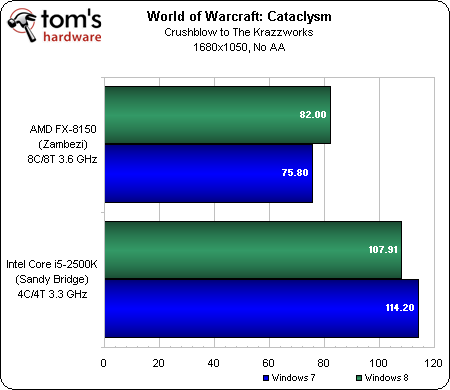AMD Bulldozer Review: FX-8150 Gets Tested
Perhaps the most hotly-anticipated launch in 2011, AMD’s FX processor line-up is finally ready for prime time. Does the company’s new Bulldozer architecture have what it takes to face Intel’s Sandy Bridge and usher in a new era of competition?
Sneak Peek: AMD’s Bulldozer Architecture On Windows 8
It’s far, far too early to pass judgment on Bulldozer’s performance in Windows 8. However, we already know that Windows 7 isn’t explicitly optimized for the idea of a Bulldozer module. I’ve already talked to the guy from Microsoft who owns process management and threading subsystem in Windows (Arun Kishan), who says Windows schedules to them equally (even if that’s not optimal). And we have a good idea that the next iteration of Windows might be handling them differently.


According to AMD, Windows 8 will more intelligently align threads so that, when they can benefit from sharing a module, they will. The implication is that when two threads can be consolidated onto one module (despite the fact that they’re forced to share resources), putting an entire module to sleep and potentially enabling a higher p-state (a faster Turbo Core setting) outweighs any performance penalty tied to sharing.
I wanted to get a more comprehensive suite of tests run on Windows 8, but the developer build was having none of it. Many of our tests are scripted, and none of those would work. Some of the benchmarks that aren’t (like 3ds Max 2012) wouldn’t install at all.
SolidWorks 2010, Premiere Pro CS 5.5, and World of Warcraft all cooperated, though.

Both SolidWorks and Premiere Pro fully utilize available processing resources. The latter demonstrates no change whatsoever, scoring the same on Windows 7 and Windows 8. The former, on the other hand, ends up favoring Intel’s Core i5-2500K, shaving off eight seconds in the move to Windows 8, as the FX-8150 slows down a little.
The thing is, I wouldn’t expect to see a predictable gain in an application already exploiting available processing resources. All cores are already active; shuffling threads around won't make it any easier to jump to P0. It’s much more plausible to anticipate a speed-up in less-intensive apps, where threads are combined, modules are put to sleep, and Turbo Core is ramped up.


To that point, WoW performance increases measurably on the FX at 1680x1050, while the already-strong Core i5 takes a hit (not something we’d expect from a final build, so perhaps that's overhead-related).
Get Tom's Hardware's best news and in-depth reviews, straight to your inbox.
The results at 2560x1600 show Intel’s i5-2500K matching its Windows 7 numbers. Meanwhile, the FX-8150 makes up some of the ground lost to Intel in Windows 7.
Core Parking: Works!
Better still, core parking, the scheduling feature that loads tasks onto as few cores as possible, shutting down the rest to save power, does recognize and optimize for Bulldozer modules. In Windows 7, you’d never see a parked core on the FX-8150. Windows 8 rectifies this, and parks cores in pairs, which we interpret to be Bulldozer modules going to sleep.



Here’s one of example of what you see in Windows 7 (first shot), one example of Windows 8 parking two Bulldozer modules (second), and another example of three modules shut down (third).
The result is a measurable power savings. Idle system consumption under Windows 7 was 107 W. In Windows 8, with three modules parked, that number drops down to 99 W. That's a scant 9 W above Sandy Bridge, a 95 W part. Not too shabby for a 125 W challenger.
Windows 8 Hold Promise
Look, don’t expect Windows 8 to drastically change the Bulldozer architecture’s performance profile. Software is an important part of any hardware review, though, and the upcoming operating system will likely improve the results of some tests once it's finalized. It’ll almost assuredly influence power use more tangibly, as its scheduler learns how to address AMD’s design decisions.
Current page: Sneak Peek: AMD’s Bulldozer Architecture On Windows 8
Prev Page Power Consumption Next Page AMD FX-8150: The Bottom Line